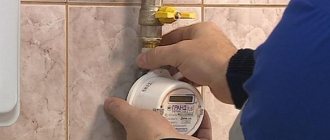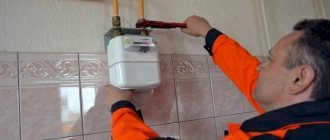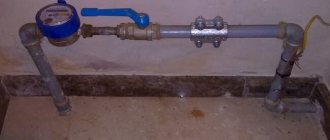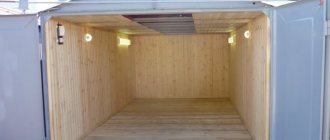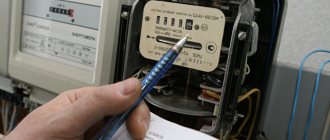Expert author of the article
Alexander Georgievich Kondratiev
An electrical engineer by training, he worked as an electronics engineer, chief engineer at a food company, and general director of a construction organization.
Utility tariffs are constantly rising, and residents are looking for legal ways to save. The main payment in winter is the payment for heating the apartment. A common house heat meter in an apartment building can significantly reduce payments. Residents of high-rise buildings should figure out whether there is any benefit from a heat meter, how to organize the installation, whether it is necessary to install it, and how the heating fee will be calculated.
Why do you need a common house appliance?
Apartment owners are already accustomed to local meters, which are installed in the apartment or on the landing. To account for thermal energy, common house thermal energy metering devices are installed. They are installed on one entrance or the whole house.
Based on the law, heat energy metering must be carried out in every apartment building. The main task that should be solved with the help of meters, as conceived by legislators, is a prudent and economical attitude to the consumption of thermal energy.
But the installation of devices is associated with significant material costs, which fall on the shoulders of the residents of the house.
These devices themselves do not save heat, they only count consumption. Savings can be achieved if residents follow certain rules. They are necessary to reduce non-standard losses, and depend on the condition of the windows, their glazing, the presence or absence of doors in the entrance, and their insulation.
Entrances, attics and basements are common property that is heated. And all residents have to pay for their heating. If you keep the window open all the time, it will be difficult to save on heating costs.
Moreover, all residents of the entrance will have to pay for this. Since the cost will be recorded by a common building metering device and distributed to all residents. Installing a heat meter will be beneficial provided:
- Residents of an apartment building take a responsible approach to the thermal insulation of their building. If the building is equipped with a heat meter, then payment for heating will be charged for the energy consumed, and not at regional tariffs, which take into account standard losses. And in each region they are different and often exceed the real ones by several times;
- Meters encourage residents to be rational about heat conservation not only in the apartment, but also in the entrance. All doors must be kept closed at all times during the cold season. The windows have been repaired and glazed. When people understand that an open door or broken window will affect the amount of payment, this will be the best incentive to keep the entrance in order;
- Installation of a heat meter will encourage management companies to take their responsibilities responsibly. Residents will require the property to be maintained in proper order. After all, they pay for these services out of their own pockets.
Meter with ITP - thermal independence
Yes, a common house meter reduces waste on heat energy by up to 30% and fully pays for itself in 3 years, but it would be nice not only to monitor heat consumption, but also to manage it. By installing not only a metering device, but also an individual heating point, consumers can regulate the temperature of the coolant supplied to the system. Also, thanks to the ITP, it becomes possible to regulate the pressure in the system - this is a significant plus, given the possible frequency of its drops, which entails pipe breaks.
It is no secret that in apartment buildings, heat can be distributed unevenly between apartments. The reason for this phenomenon lies in the imbalance of the heating system. Agree, the situation is familiar: in apartments on the upper floors the heat is unbearable, while on the lower floors the radiators are slightly warmer than icy (or vice versa). ITP easily eliminates this problem too.
Equipping it is quite simple: a heat exchanger, a couple of pumps, wiring and the heat meter itself.
Legislative basis
Installation of devices is mandatory for all apartment buildings. What is regulated by Federal Law No. 261-FZ of November 23, 2009 and amendments that entered into force on August 10, 2018, “On energy saving and increasing energy efficiency, and on introducing amendments to certain legislative acts of the Russian Federation.”
However, the implementation of this law is associated with some features:
- The purchase, installation and commissioning works are paid for by the residents of the house. And after commissioning, the equipment becomes household property. Moreover, the costs of acquisition, design and commissioning amount to quite large amounts;
- Regular maintenance is required to keep equipment in good working order. It also falls on the shoulders of the residents. And when concluding a service agreement with the management company, residents will be billed for maintenance;
- The law does not regulate equipment failure. If the meter readings are inflated, residents will not be able to prove anything. They will have to pay for heat based on the meter readings;
- Residents of non-privatized apartments may not pay the cost of a common building meter for heat. By law, all costs must be borne by the building owner. This may be a municipal government or an organization in whose department the property is located.
How to convey testimony correctly
An apartment heat meter is functionally much simpler than a modern mobile phone, but users periodically have misunderstandings about the process of taking and sending display readings.
To prevent such situations, before starting the procedure for taking and transmitting readings, it is recommended to carefully study its passport, which provides answers to most questions related to the characteristics and maintenance of the device.
Depending on the design features of the device, data is collected in the following ways:
- From the liquid crystal display by visually capturing readings from various menu sections, which are switched by a button.
- ORTO transmitter , which is included in the basic package of European devices. The method allows you to display and print extended information about the operation of the device on a PC.
- The M-Bus module is included in the delivery of individual meters in order to connect the device to the centralized data collection network of heat supply organizations. Thus, a group of devices is combined into a low-current network using a twisted pair cable and connected to a hub, which periodically polls them. Afterwards, a report is generated and delivered to the heat supply organization, or displayed on a computer display.
- The radio module included in the delivery of some meters transmits data wirelessly over a distance of several hundred meters. When the receiver comes within range of the signal, the readings are recorded and delivered to the heat supply organization. Thus, the receiver is sometimes attached to a garbage truck, which, as it follows a route, collects data from nearby meters.
Archiving of readings
All electronic heat meters store in the archive data on accumulated indicators of thermal energy consumption, operating and idle time, coolant temperature in the forward and return pipelines, total operating time and error codes.
As standard, the device is configured for various archiving modes:
- hourly;
- daily;
- monthly;
- annual.
Some of the data, such as total operating time and error codes, can only be read using a PC and special software installed on it.
Heat meters for heating in an apartment - how to choose and install correctly?
To avoid problems with paying receipts, it is necessary to submit water meter readings in a timely manner; how to do this correctly, read on.
Calculation of heat from underfloor heating, detailed article -
Transfer of readings via the Internet
One of the most convenient ways to transmit readings of consumed thermal energy to institutions for its accounting is transmission via the Internet. Its convenience and practicality lies in the ability to independently control payments and debts, as well as track heat consumption at different periods without standing in queues and spending a small amount of time.
To do this, you must have a personal computer connected to the network and the address of the website of the controlling organization, as well as the login and password of your personal account, after logging into which a form for entering readings will open. To prevent disagreements from arising in the event of a possible failure or malfunction on the site, it is advisable to take “screenshots” of the screen after entering information.
At what objects is a meter needed, and where is it not necessary to install it?
The law determines that all owners of buildings, houses, and apartments are required to equip their buildings with communal heating meters by 2011. What is regulated by Article 13, Section 4 of Federal Law No. 261.
And section 3 obliges all government organizations to equip them with thermal appliances. However, Section 1 of Article 13 indicates facilities where the installation of meters is not required.
These are emergency or dilapidated buildings, structures that are subject to demolition. There is no need to install heat meters on houses with a maximum consumption of thermal energy not exceeding two tenths of a gigacalorie per hour.
Is it possible to refuse to install a common house heat meter?
According to the law, all apartment buildings must be equipped with communal heat meters. Exceptions apply to houses specified in Section 1 of Article 13. As well as to buildings whose communications require major repairs or do not allow the installation of meters for other reasons.
In all other cases, the law requires the installation and installation of equipment. And newly commissioned housing will not be put into operation without a heat meter installed.
Types of heat meters: which one is better to choose
Before installing a heating meter for an apartment building, you should familiarize yourself in detail with its main characteristics and operating principle. Today there are several types of heat meters, among which are:
- Mechanical meters are currently considered the cheapest and simplest. The basic principle of operation of these devices is to convert the translational movements of the coolant into the movement of a special measuring system. Typically, turbine, screw and vane types of mechanical heat meters are distinguished. It should also be noted that such devices are strictly not recommended for use with hard water - this can lead to clogging of the device with scale and other sedimentary substances. In this case, the best option would be to use a special filter for water purification.
- Electromagnetic meters operate on the principle of the generation of electric current as a result of the passage of an electronic carrier through a magnetic field.
- Vortex heat metering devices operate on the principle of detecting and analyzing vortex that appears directly in the path of coolant movement. It should be noted that this type of meter reacts negatively to the presence of significant impurities in the coolant, as well as to sudden changes in temperature and air in the lines.
- Ultrasonic heat meters are currently among the most accurate and efficient. The operating principle of this type of metering device is based on the passage of a special sound signal through the coolant, as well as the indicator of the time during which the coolant arrives from the primary source to the ultrasonic signal receiver.
How much does it cost and who pays
The issue of the cost of equipment and related services becomes paramount. Since, according to the law, residents of an apartment building must pay for equipment, design, commissioning and commissioning.
As a result, the common building meter becomes the collective property of the residents. The cost of heat meters depends on the manufacturer and type of equipment:
- Inexpensive devices with a short service life of 2 to 4 years, costing from 6 to 10 thousand rubles. These are meters that use a rotor as an actuator;
- More reliable electronic devices cost from 15 to 100 thousand rubles. The service life of such devices is 10-15 years.
But this is not the main price you need to pay for installation.
Total costs consist of the following expense items:
- Design work. This includes the development and approval of the project. The estimated cost is 50 thousand rubles;
- Heat meter. Usually they choose reliable devices in the middle price category of about 60 thousand rubles. With a service life of at least 10 years;
- Additional equipment, flow meters and sensors. The price of the devices is 40 thousand rubles;
- Installation of equipment and auxiliary materials. Repair of worn-out networks is taken into account. The cost of the work is 90 thousand rubles;
- Equipment setup and commissioning costs 10 thousand rubles.
The cost of installation and commissioning of a thermal energy meter ranges from 180 to 300 thousand rubles. This is the estimated price for the work. It depends on the organization that will perform installation, commissioning and commissioning.
The management company does not perform this work; they require special permission.
Principle of operation
The operation of the heat meter is based on the principle of calculating the amount of heat using data taken from a coolant flow sensor and a pair of temperature sensors. The amount of water passing through the heating system is measured, as well as the temperature difference at the inlet and outlet.
The amount of heat is calculated by the product of the flow rate of water passing through the heating system and the difference in temperature of the incoming and outgoing coolant, which is expressed by the formula
Q = G * (t1-t2) , gCal/h, in which:
- G – mass flow of water, t/h;
- T1,2 – temperature indicators of water at the inlet and outlet of the system, °C.
All data from the sensors is sent to the computer, which, after processing it, determines the value of heat consumption and records the result in the archive. The value of consumed heat is displayed on the device display and can be taken at any time.
What affects the accuracy of the heat meter
Techem compact V
A heat meter, like any precision device, when measuring consumed heat has a certain total error, which is the sum of the errors of the temperature sensors, flow meter and calculator. In apartment accounting, devices are used that have an acceptable error of 6-10%. The actual error may exceed the basic one, depending on the technical characteristics of the component elements.
The increase in the indicator is determined by the following factors:
- The amplitude of the incoming and outgoing coolant temperatures, which is less than 30°C .
- Violations during installation in accordance with the manufacturer's requirements (if installed by an unlicensed organization, the manufacturer will withdraw its warranty obligations).
- Poor quality of pipes, hard water used in the coolant, and the presence of mechanical impurities in it.
- When the coolant flow rate is below the minimum value indicated in the technical specifications of the device.
How is heat consumed measured?
It is customary to calculate the tariff for consumed heat in gigacalories. The unit of measurement is non-systemic, and has traditionally been used since the existence of the USSR. Devices manufactured in Europe calculate heat consumption in GigaJoules (SI system), or the generally accepted international non-systemic unit kWh (kWh) .
Differences in measurement systems among employees of heat supply organizations do not cause any particular difficulties in how to calculate heating charges, since some units are easily converted to others using a certain coefficient.
Is it possible not to pay for installing a meter?
In some cases, a heat meter can be installed free of charge. This option is possible when residents do not have the funds to pay for a heat meter.
The management company or homeowners association enters into an energy service contract. According to it, the energy service company purchases and installs equipment at its own expense.
After installing the structure and putting it into operation, the heat meter is leased. Payment for equipment is made at the rate of 80% of the savings achieved. The energy service company takes it, and 20% remains the property of the residents.
For example, a house paid 400 thousand rubles for heat before installing a meter. After installation, the payment decreased to 350 thousand. Saving 50 thousand rubles. The energy supply company takes 40 thousand rubles.
According to the leasing agreement, she receives 300 thousand. Thus, after (300/40=7.5) 7.5 months, the equipment will be transferred to the residents of the house. After the heat meter is handed over to the residents, all savings are distributed among the apartment owners.
Read what the temperature in the apartment should be during the heating season and how to request a recalculation for cold radiators.
Calculation of tariffs for services in public places
Public places include the following:
- Basement.
- Entrance.
- Flights and landings.
- All kinds of storage rooms.
If we are talking about communal apartments, which are still found, then areas such as the bathroom, kitchen and corridor are added to this list. In other words, this is absolutely any place where all owners living nearby have access.
Such objects, as you know, are lit and heated, and payments are distributed to all owners. Calculations for such “public” services are carried out according to a special formula with such indicators as:
- C (general) – payment for the service provided in public places.
- P – parameters of common house appliances.
- T – tariff for services relevant for a certain region.
- C (ind) – payment for each resident according to individual meters.
The calculation formula looks like this: the volume of the resource provided is divided by the volume of consumed, recorded in the installed meters.
The result calculated during the calculation process in kilowatts or cubic meters is translated into a monetary amount that must be paid by all residents. It is divided among all owners of residential premises.
Procedure for residents and management companies when installing meters
Home owners should start with a general meeting. It is usually carried out by the management company. This is where the decision to install equipment is made.
Select the type of device and approve the preliminary budget. After the meeting, a contractor is selected and an agreement is concluded with it to perform the work.
Together with the management organization, residents monitor the progress of work. If necessary, adjustments are made. Participate in testing. They are present when the facility is handed over to the heat supply company, which seals the devices and draws up a commissioning report.
Only after the heat supply company has accepted the work, the meter readings are the basis for payment for heat.
At the same time, you do not need to rely on the management company. She can organize a general meeting of residents, explain the need to install a meter, and draw up the relevant documents. And in some cases, help select a contractor.
But choosing a contractor, purchasing equipment, drawing up contracts for installation and commissioning work fall on the shoulders of the residents of an apartment building.
What types of communal meters are there?
The industry produces several types of metering devices. They differ in performance and operating principles.
Mechanical
A tachometer or mechanical counter records the passage of coolant using an impeller or rotor. The rotor revolutions are counted by a computing unit.
The structure includes heat sensors and a computing unit. This is a device designed for a small home.
The mechanism is demanding on the quality of the coolant. In networks with low-quality coolant, dirty and hard water, tachometer meters are not installed. During installation, it is necessary to install a magnetic-mechanical filter.
Ultrasonic
The measuring principle is based on the passage of ultrasound through a stream of water. The devices are sensitive to mechanical inclusions and air bubbles in the coolant.
If they are present in water, it is impossible to obtain reliable data. This is an expensive and reliable device. Can work for a long time with high-quality coolant.
Electromagnetic
Accounting is carried out on the basis of counting the passage of liquid processed by a magnetic field in an electromagnetic unit. Where the liquid is magnetized, and in special modules the coolant is calculated.
Installation is carried out by trained specialists. Requires constant maintenance. With proper maintenance it works for a long time without repair.
The advantages include high accuracy of readings. If metal impurities are present in the coolant, the device readings will be unstable.
Vortex
The design uses the principle of vortex counting. An obstacle is placed in the path of the coolant, which creates turbulence. Their number depends on the flow.
The structure can be installed on both horizontal and vertical sections of the system. Pressure changes affect readings.
For normal operation of the heat meter, a filter for mechanical cleaning of the coolant is installed. They are not sensitive to small metal inclusions.
Additional technical information
- If the heat consumption is insignificant, and the heating system has a high pressure, the installation of inexpensive mechanical meters is allowed. When, on the contrary, the flow rate is significant and the pressure is small, the consumption of thermal energy will be recorded more accurately by an electromagnetic or ultrasonic device. By the way, most of the installations include house-wide ultrasonic devices.
- In addition to heat, metering devices record the consumption of hot water; now modern device models count coolant with a temperature of less than 40 degrees as cold, which is reflected in the amount of payment for heat supply.
- A useful measure for an apartment building would be to conduct an energy audit to identify the causes of heat loss. Then measures should be taken to eliminate them. Of course, such work will be expensive.
- When it is decided to install a mechanical meter, in addition to installing coarse filters, it is necessary to use a magnetic-mechanical filter in steel pipes to retain scale and rust. It is capable of filtering out metal particles that are so small that they pass through the mesh.
Purchase and installation of a common house heat meter
Before the general meeting where a decision on the type of meter will be made, it is recommended to contact an organization that installs and maintains heat metering devices.
The contractor's engineers, on the instructions of the residents, will carry out the following work:
- Audit of the home heating system;
- Based on the audit data, they will recommend the type of device that will meet all the necessary requirements. It should be taken into account that many meters have blocks for remote data transfer. And the service life must be at least 10 years;
- They will develop design documentation, install and commission the meter;
- After the end of the warranty period, maintenance of heat meters will be carried out.
When applying, you should find out whether the company has permission to perform this type of work.
What types of devices are there?
Each heat meter is a set of devices that includes sensors, units responsible for recording consumed heat, and all kinds of converters that work with pressure, flow and resistance indicators of the coolant.
The meter's configuration is determined by the manufacturer and differs depending on the model. The most common are ultrasonic and mechanical devices, while vortex and electromagnetic devices are practically unpopular due to their complexity and high cost.
There are also calculators and thermal energy distributors that do not need to be built into the thermal circuit; such devices can be used in absolutely any circuit.
| Type | Peculiarities |
| Mechanical | The simplest type of design, therefore its price is quite low and is at the level of 9-10 thousand rubles. This is a device with wired temperature sensors, a water meter and an electronic unit. The working element is a part that rotates as the coolant passes through the device, and it is the number of revolutions that determines the volume passed through the device. Two thermometers are placed on the supply and return pipes, and this can be done both vertically and horizontally |
| Ultrasonic | The amount of media consumed in this type of device determines the ultrasonic signal thanks to the emitter and receiver, while they are mounted on a horizontal pipe, but with a certain distance. The emitter signal travels through the water and reaches the receiver, and the time is calculated based on the speed of water movement in the circuit. Ultrasonic samples can regulate the flow in some variations, but this is the domain of advanced models |
| Calculators and distributors | These devices measure relative heat costs and consist of thermal adapters and two sensors. Once every three minutes, sensors measure the temperature, being installed on the battery and in the room, while displaying the difference in values. The information that is received is displayed on the display. These devices are programmed in advance for coefficients and radiator power, and as a result, the heat consumption indicator will be displayed in kilowatt-hours |
Calculation of payments for intra-apartment and communal heat energy consumption
All residents are concerned about the question of how heating fees in an apartment building are calculated. This is the most significant amount on the payment receipt. There are several options for paying for consumed heat. There are only three such options.
Option No. 1: The house has a common house meter, and the apartments have individual heat meters
This accounting system is used in new buildings. Apartment heating in houses is carried out with horizontal wiring. This made it possible to install one individual meter per apartment.
Residents make payments based on individual meter readings. However, in this case, the costs of heat spent on heating common property - entrances, attics, etc. - are not taken into account.
Read about how payment is calculated for an individual heat meter in an apartment building.
To pay for common areas, the following calculation formula is used. Readings from local devices are taken. They are summed up and subtracted from the readings of the common house meter. The difference is divided among all residents in proportion to the area of the apartment occupied by the owner.
Option No. 2: the house has a communal meter, the apartments do not have meters
Heating bills are calculated according to the following algorithm:
- The area of all heated premises is taken. This includes attics, basements and entryways. The meter readings, multiplied by the tariff, are divided by the total area. We get the cost of one square meter;
- The common house share is calculated for each apartment;
- The common house share is added to the area of the apartment;
- The total area is multiplied by the cost of heating one square meter.
This will be the heating charge for each apartment.
Option No. 3: There are no heat meters
This option shouldn't exist. However, not all houses have communal meters. And what a situation will last for several more years.
Payment is calculated based on the area of the apartment. The share of the common house heated area is added to this area.
The resulting value is multiplied by the tariff. In each region, local authorities approve their own tariff. They operate throughout the heating season or are distributed evenly throughout the year.
This allows you to reduce “winter” payments. At the end of the heating season, a recalculation is performed based on actual temperature changes.
Based on the recalculation results, residents receive compensation (the overpayment is counted toward future payments) or pay extra and receive a new bill for consumed heat.
Is it possible to save money on heating at all?
From the above information we can conclude that a common house meter does not provide obvious benefits for residents. However, there are ways that will help you save money - these are individual heat meters installed in conjunction with thermostatic control devices for heating radiators.
Having such a device, you can independently control and regulate the heat supplied to the premises. In addition, if metering and temperature control devices are installed in all apartments of the house, this will allow their owners to be less dependent on each other.
Thermostatic regulator on the heating radiator - the room is maintained at the set temperature
- An individual metering device is mounted at the entrance of the heating pipes to the apartment. The meter must be sealed by representatives of the organization controlling the heat supply, otherwise its readings will be considered invalid.
- Thermostatic regulators are installed at the heating radiator inputs. A simplified option is chokes (regular or specially designed valves). thermostats. Of course, they are more expensive, but they make it easier to accurately regulate the temperature of each radiator individually. Thus, you can achieve a comfortable temperature in the rooms and not suffer from the heat by opening the windows when it’s +10÷15 degrees outside, and utilities are heated as if at -20˚C.
The best option is digital or mechanical thermostats. The thermostat head is installed so that it does not end up in the flow of hot air rising from the heating device. A special bellows device (expanding or decreasing in volume as the air temperature in the room changes) acts on the thermal valve rod, which reduces or increases the cross-section of the coolant passage into the radiator.
Thermostats for heating radiators – how justified are they, and how to install them yourself?
You can rest assured that the device is very useful in terms of maintaining a comfortable temperature in the room. And installing it is not so difficult on your own: no approvals are required, you just need to comply with some conditions. more about the design and installation of thermostats on heating radiators in a special publication on our portal.
As mentioned above, if radiators are connected to different heating risers, then metering devices will have to be installed on each riser. And it is absolutely not a fact that they will be able to pay for themselves, since, in addition to the purchase, you will have to spend money on their maintenance, testing and possible periodic repairs.
Digital thermometer mounted on a radiator.
There is another way to measure the heat spent on heating an apartment - an electric thermometer, which takes and records temperature readings from the surface of the radiator, as well as the air in the room. Such a device has a very affordable price, and it is not difficult to install it yourself - it is attached directly to the surface of the battery.
But such a device will in no way affect the payment for consumed heat - its readings have informational, but not official registration value. Having information about the operation of an individual radiator for a certain period, as well as about the total costs of all radiators, you can only roughly estimate the costs of heat for the entire apartment. This factor will be a good incentive to save money or find a “weak spot” in the thermal insulation system in order to eliminate the emerging heat leakage path. Thanks to this, overall heating costs can be significantly reduced.
But this increasingly applies to private houses or individual heating systems in apartments.

